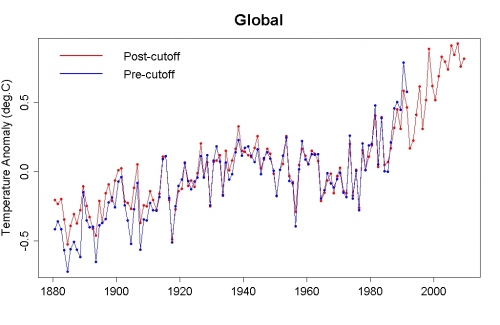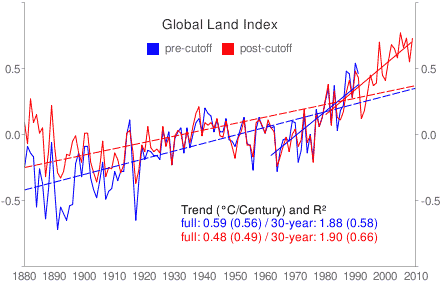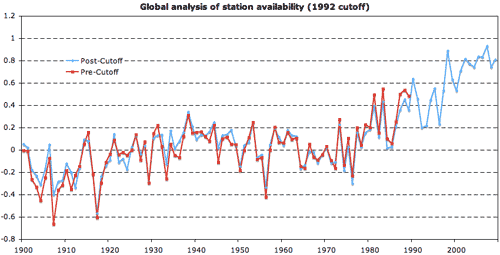Why are there fewer weather stations and what's the effect?
Posted on 28 April 2010 by John Cook
The NOAA and NASA obtain their temperature data from the Global Historical Climatology Network (GHCN). In the early 1990s, the number of weather stations listed in the GCHN drops rather sharply. Some have suggested this is a deliberate campaign to remove cooler weather stations in order to inflate the warming trend. The driving force behind this idea comes from Joseph D'Aleo in an online report Surface Temperature Records: Policy Driven Deception co-written with Anthony Watts. Initially, their report stated that "There has been a severe bias towards removing higher-altitude, higher-latitude, and rural stations, leading to a further serious overstatement of warming." This text has been removed from the latest edition of their report. Nevertheless, the notion that removed stations is causing spurious warming continues to be repeated throughout the blogosphere (and often in comments here on Skeptical Science).
Why are there currently fewer stations in the temperature record? The physical number of weather stations that are reporting temperature data has diminished - some of the older outposts are no longer accessible in real time (NOAA). In fact, the perceived "drop-off" is exacerbated by the fact that the NOAA have been actively adding historical data into the GCHN database from older weather stations that are no longer active, in an attempt to provide more comprehensive coverage of the past.
The most important issue is whether this drop-off in the number of reporting weather stations has had any impact on the temperature record. D'Aleo's report performs no such analysis. However, there have been a number of independent analyses examining this very question. The first analysis was conducted by Tamino, from Open Mind, who plotted the temperature data from the weather stations that were dropped from the GHCN record (labelled 'pre-cutoff'). He then compared this to the temperature data from the weather stations that were kept (labelled 'post-cutoff').

Figure 1: Temperature history for pre-cutoff stations only (blue) compared to that for post-cutoff stations only (red) (Open Mind).
What's interesting about this graph is not only that there is little difference between the two plots but that the dropped weather stations actually show a greater warming trend than the kept weather stations. This is not surprising considering many of the dropped weather stations are from higher latitude sites. While these regions have a cooler absolute temperature, they show a greater warming trend. This is the result of polar amplification - warming at the tropics is less than warming at the poles due to various effects such as positive feedback from ice albedo changes.
An independent analysis was performed by Clear Climate Code who also compared the temperature data from dropped stations versus kept stations. He also plotted trend lines to compare the long-term warming trend from both types of stations.

Figure 2: The "before 1992 / after 1992 stations" from “The 1990s station dropout does not have a warming effect” (Clear Climate Code)
Similar to Tamino's results, Clear Climate Code found that the dropped weather stations show a greater warming trend than the kept weather stations. The difference seems to be largely due to a divergence in the older, 19th century data. However, they also plotted the trend for the last 30 years of both records. The warming trend from 1962 to 1992 for the dropped weather stations is nearly identical to the warming trend from 1979 to 2009 for the kept weather stations.
Just for good measure, another analysis was independently performed by Zeke Hausfather at The Blackboard (there are others that also find the same result but I wouldn't want this post to get monotonous):

Figure 3: Comparison of stations with records post-1992 to those without (The Blackboard).
So the reason for the "dropped" weather stations is merely the result of stations no longer actively recording temperature data. More importantly, the removal of dropped stations does not cause a spurious warming trend. In fact, the opposite is true as the removal of high latitude sites imposes a slight cooling trend since 1880. The change in warming trend since 1970 is negligible.
UPDATE 29 April 2010: Mark Richardson informs me of a blog post by Roy Spencer that compares the GCHN record to his own temperature record that uses a much broader range of weather stations combined with the satellite record and finds pretty much an identical warming trend.































 Arguments
Arguments































Since debating this subject with Ned on another thread I posted a response relating to the station drop off problem in the Canadian Arctic: http://www.skepticalscience.com/news.php?p=2&t=81&&n=164 The above post is based on correspondence with Environment Canada and NOAA/NCDC that demonstrates John Cook made an incorrect statement at the head of this thread when he said: "The physical number of weather stations that are reporting temperature data has diminished......" There are 37 stations to GCN/WMO standards reporting in the Canadian Arctic. The data from all of them is available to the NCDC but only Eureka appears consistently in GHCN v2. I still don't know why the number of stations in the Canadian Arctic has fallen dramatically so I am planning a trip to NCDC in Asheville next month. If I learn anything I will let y'all know. If you still think that a very thin data set does not affect published results take a look at what happened on July 13, 2009 and March 29, 2010 (thank you, Berenyi Peter): [LINK] A temperature anomaly of 4 degrees Celsius for March 2010 should raise a few eyebrows!
[DB] Shortened link breaking page formatting.